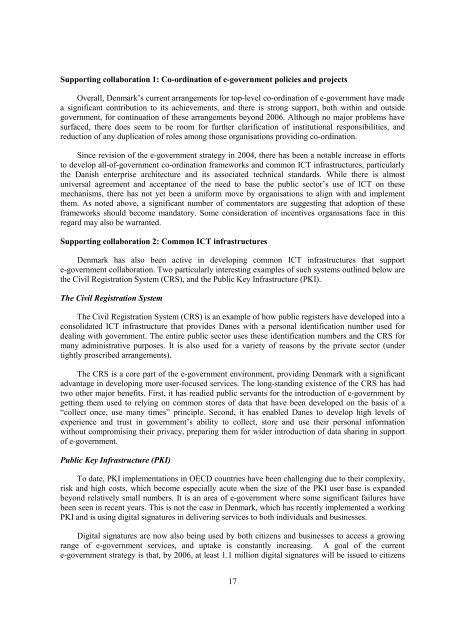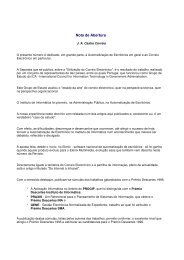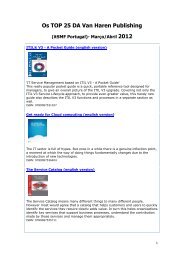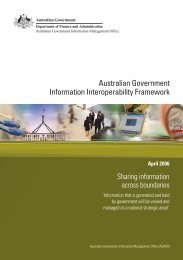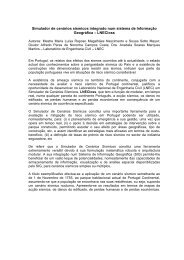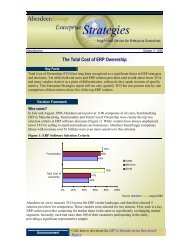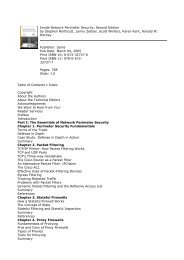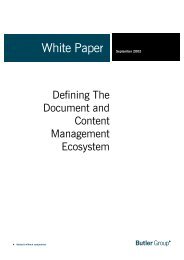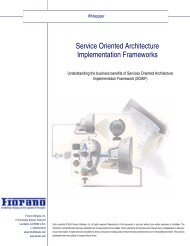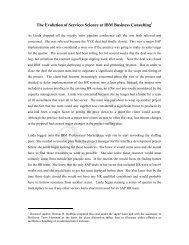OECD Peer Review of E-Government in Denmark - ePractice.eu
OECD Peer Review of E-Government in Denmark - ePractice.eu
OECD Peer Review of E-Government in Denmark - ePractice.eu
You also want an ePaper? Increase the reach of your titles
YUMPU automatically turns print PDFs into web optimized ePapers that Google loves.
Support<strong>in</strong>g collaboration 1: Co-ord<strong>in</strong>ation <strong>of</strong> e-government policies and projects<br />
Overall, <strong>Denmark</strong>’s current arrangements for top-level co-ord<strong>in</strong>ation <strong>of</strong> e-government have made<br />
a significant contribution to its achievements, and there is strong support, both with<strong>in</strong> and outside<br />
government, for cont<strong>in</strong>uation <strong>of</strong> these arrangements beyond 2006. Although no major problems have<br />
surfaced, there does seem to be room for further clarification <strong>of</strong> <strong>in</strong>stitutional responsibilities, and<br />
reduction <strong>of</strong> any duplication <strong>of</strong> roles among those organisations provid<strong>in</strong>g co-ord<strong>in</strong>ation.<br />
S<strong>in</strong>ce revision <strong>of</strong> the e-government strategy <strong>in</strong> 2004, there has been a notable <strong>in</strong>crease <strong>in</strong> efforts<br />
to develop all-<strong>of</strong>-government co-ord<strong>in</strong>ation frameworks and common ICT <strong>in</strong>frastructures, particularly<br />
the Danish enterprise architecture and its associated technical standards. While there is almost<br />
universal agreement and acceptance <strong>of</strong> the need to base the public sector’s use <strong>of</strong> ICT on these<br />
mechanisms, there has not yet been a uniform move by organisations to align with and implement<br />
them. As noted above, a significant number <strong>of</strong> commentators are suggest<strong>in</strong>g that adoption <strong>of</strong> these<br />
frameworks should become mandatory. Some consideration <strong>of</strong> <strong>in</strong>centives organisations face <strong>in</strong> this<br />
regard may also be warranted.<br />
Support<strong>in</strong>g collaboration 2: Common ICT <strong>in</strong>frastructures<br />
<strong>Denmark</strong> has also been active <strong>in</strong> develop<strong>in</strong>g common ICT <strong>in</strong>frastructures that support<br />
e-government collaboration. Two particularly <strong>in</strong>terest<strong>in</strong>g examples <strong>of</strong> such systems outl<strong>in</strong>ed below are<br />
the Civil Registration System (CRS), and the Public Key Infrastructure (PKI).<br />
The Civil Registration System<br />
The Civil Registration System (CRS) is an example <strong>of</strong> how public registers have developed <strong>in</strong>to a<br />
consolidated ICT <strong>in</strong>frastructure that provides Danes with a personal identification number used for<br />
deal<strong>in</strong>g with government. The entire public sector uses these identification numbers and the CRS for<br />
many adm<strong>in</strong>istrative purposes. It is also used for a variety <strong>of</strong> reasons by the private sector (under<br />
tightly proscribed arrangements).<br />
The CRS is a core part <strong>of</strong> the e-government environment, provid<strong>in</strong>g <strong>Denmark</strong> with a significant<br />
advantage <strong>in</strong> develop<strong>in</strong>g more user-focused services. The long-stand<strong>in</strong>g existence <strong>of</strong> the CRS has had<br />
two other major benefits. First, it has readied public servants for the <strong>in</strong>troduction <strong>of</strong> e-government by<br />
gett<strong>in</strong>g them used to rely<strong>in</strong>g on common stores <strong>of</strong> data that have been developed on the basis <strong>of</strong> a<br />
“collect once, use many times” pr<strong>in</strong>ciple. Second, it has enabled Danes to develop high levels <strong>of</strong><br />
experience and trust <strong>in</strong> government’s ability to collect, store and use their personal <strong>in</strong>formation<br />
without compromis<strong>in</strong>g their privacy, prepar<strong>in</strong>g them for wider <strong>in</strong>troduction <strong>of</strong> data shar<strong>in</strong>g <strong>in</strong> support<br />
<strong>of</strong> e-government.<br />
Public Key Infrastructure (PKI)<br />
To date, PKI implementations <strong>in</strong> <strong>OECD</strong> countries have been challeng<strong>in</strong>g due to their complexity,<br />
risk and high costs, which become especially acute when the size <strong>of</strong> the PKI user base is expanded<br />
beyond relatively small numbers. It is an area <strong>of</strong> e-government where some significant failures have<br />
been seen <strong>in</strong> recent years. This is not the case <strong>in</strong> <strong>Denmark</strong>, which has recently implemented a work<strong>in</strong>g<br />
PKI and is us<strong>in</strong>g digital signatures <strong>in</strong> deliver<strong>in</strong>g services to both <strong>in</strong>dividuals and bus<strong>in</strong>esses.<br />
Digital signatures are now also be<strong>in</strong>g used by both citizens and bus<strong>in</strong>esses to access a grow<strong>in</strong>g<br />
range <strong>of</strong> e-government services, and uptake is constantly <strong>in</strong>creas<strong>in</strong>g. A goal <strong>of</strong> the current<br />
e-government strategy is that, by 2006, at least 1.1 million digital signatures will be issued to citizens<br />
17


